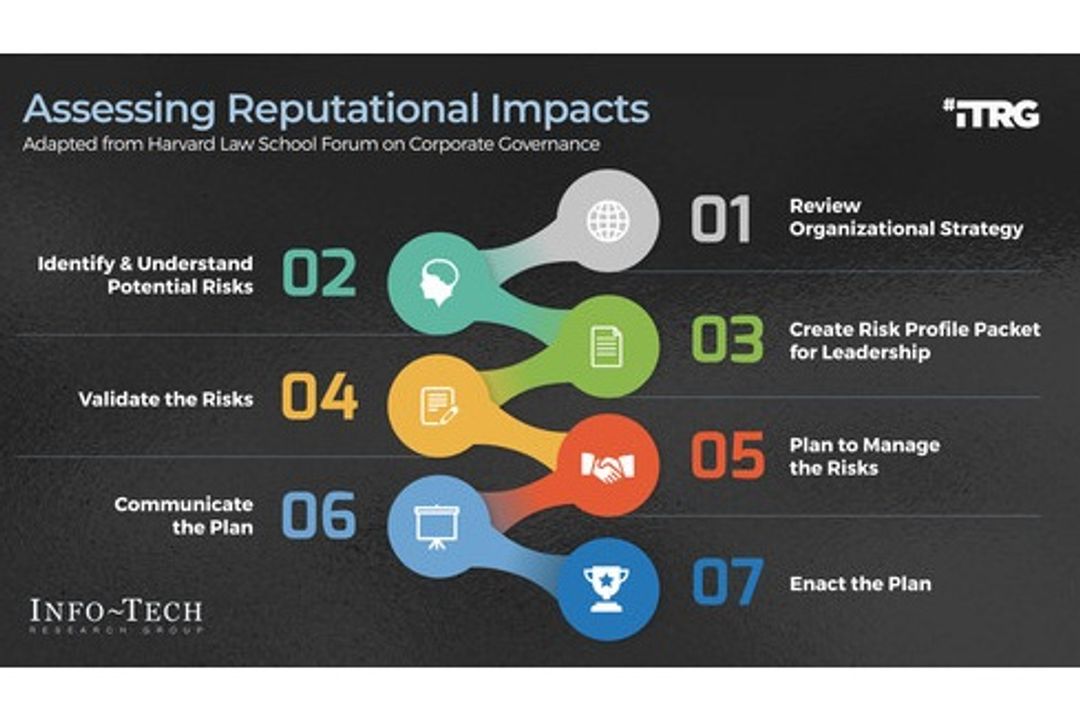TORONTO – Info-Tech Research Group, one of the world’s leading IT research and advisory firms, has published its newest industry resource, Identify and Manage Reputational Risk Impacts on Your Organization. This highly relevant research will assist organizational leaders in the ongoing monitoring of social media and the vendors associated with their brand as well as evolving organizational risk assessments to be more adaptive to respond to the rapid changes in online media. The research outlines that consistent monitoring of social media and the vendors tied to their company is imperative to achieving success and avoiding reputational disasters
“Social media, unprecedented access to good and bad information, and consumer reliance on online opinions have forced organizations to dedicate more resources to protecting their brand reputation than ever before,” says Frank Sewell, research director of vendor management at Info-Tech Research Group. “Perceptions matter, and you should monitor and protect the perception of your organization with as much rigor as possible to ensure your brand remains recognizable and trusted.”
In the digital economy, access to information about companies is more available to consumers than ever. Negative events, such as a data breach, service disruption, or customer complaint, are becoming increasingly common and could impact an organization’s reputation at any time. Info-Tech’s research points to the need to continuously monitor vendor actions in the market to help organizations address brand disasters before they occur. As such, organizations can and must implement mechanisms to monitor and manage how information is perceived to avoid potentially disastrous consequences to the brand’s reputation.
The timely new research from Info-Tech Research Group highlights seven key steps for leaders to take in assessing reputational risk impacts to help streamline their risk identification, assessment, and management processes. Those steps are:
- Review Organizational Strategy – Leaders should review the organizational strategy to prepare for a “what if” exercise. This activity is recommended as a best practice and includes asking probing questions to draw out, understand, and eliminate possible negative outcomes.
- Identify & Understand Potential Risks – Execute the “what if” game with the right people at the table. As an example, this might include organizational leadership, the vendor management coordinator, operations experts (SMEs), marketing team members, and legal, compliance, and risk managers.
- Create a Risk Profile Packet for Leadership – Pull all the determined information together in a presentation document. This will act as a comprehensive reputational risk profile, including specific vendor solutions, for future reference.
- Validate the Risks – Collaboration across leadership throughout the organization is important to ensure that the proposed risks are in line with their thoughts and make a list of identified potential risk scenarios scored by likelihood and financial impact.
- Plan to Manage the Risks – Lower the overall risk potential by putting mitigations in place and creating a list of potential management of the scenarios to reduce the risk.
- Communicate the Plan – It is crucial to not only to have a plan but also to socialize it in the organization for awareness. A risk management plan is only as useful as it is understood, so organizational buy-in and comprehension are crucial to its success.
- Enact the Plan – Once the plan is finalized and socialized, it should be implemented in conjunction with continued monitoring for success.
“All we are at our core is our reputation and our brand, and they are intertwined,” says Phil Bode, principal research director at Info-Tech Research Group. “Organizational leadership is often caught unaware during crises, with response plans lacking the flexibility to adjust to significant market upheavals as a result. Vendor management practices serve to educate organizations and their leadership on the different potential risks to vendors in their respective markets, suggesting creative and alternative ways to both avoid and help manage them.”
For organizational leaders seeking to minimize potential reputational risks to their brand, Identify and Manage Reputational Risk Impacts on Your Organization is now available to download.
To learn more about Info-Tech Research Group and to download the latest research, visit infotech.com and connect via LinkedIn, Twitter, and Facebook.

